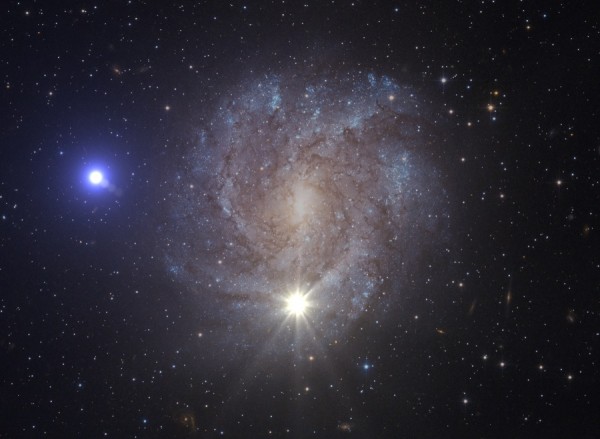Milky Way's Fastest Star is Leaving it at 26 Million mph
| Ana Verayo | | Mar 08, 2015 12:40 AM EST |
(Photo : ESA/HUBBLE, NASA, S. GEIER) An artist impression of the mass-transfer phase followed by a double-detonation supernova that led to the ejection of US 708.
A new study revealed that the Milky Way's fastest spinning star is already on its way out of the galaxy, and suggests a supernova caused the star to be ejected.
The star called US 708 is moving at an incredible speed of 26 million miles per hour, making it the fastest star astronomers have observed. At this speed, the out of control star will escape the Milky Way's powerful gravitational forces and make its way towards intergalactic space.
Like Us on Facebook
Researchers say these hypervelocity stars (HVS') usually speed out of the galaxy when the massive forces from the black hole located at the center of the galaxy throw them off course. The origin of US 708 is quite different from the rest of the HVS', however.
The fast traveling star was probably launched by a Type Ia supernova, the source of the universe's brightest and most powerful bursts of energy. Scientists are still studying how these exploding stars work and hope US 708 can provide clues.
Scientists believe US 708 was most likely in an orbit with another host star, and the two stars began orbiting each other too fast because of the very small distance between them.
The companion star exploded into a supernova and was destroyed completely. The lone US 708 was now without a gravitational leash that would have kept it in place as that enormous energy and rotational speed resulted in a fast moving one directional path.
This fast star is classified by astronomers as a hot subdwarf, which was first discovered in 2005. Using the Keck II telescope's Echellette Spectrograph and Imager instrument, astronomers measured the star's distance and velocity.
According to Stephan Geier of the European Southern Observatory during the reconstruction of its trajectory, the galactic center became an unlikely source of its origin but this is highly inconsistent with the most favorable ejection mechanism found in other HVS'.
He adds the team concluded from their binary star evolution model that US 708 was indeed spun up by a tidal interaction caused by a close binary star, and most likely ejected as a remnant from a very powerful, thermonuclear supernova.
This study was published in the journal, Science.
TagsMilky Way's Fastest Star is Now Travelling at 26 Million Miles Per Hour Out of the Galaxy, fastest star in Milky Way, Milky Way, US 708 galaxy, Supernova, milky way fastest star supernova, ESO, keck observatory
©2015 Chinatopix All rights reserved. Do not reproduce without permission
EDITOR'S PICKS
-

Did the Trump administration just announce plans for a trade war with ‘hostile’ China and Russia?
-

US Senate passes Taiwan travel bill slammed by China
-

As Yan Sihong’s family grieves, here are other Chinese students who went missing abroad. Some have never been found
-

Beijing blasts Western critics who ‘smear China’ with the term sharp power
-

China Envoy Seeks to Defuse Tensions With U.S. as a Trade War Brews
-

Singapore's Deputy PM Provides Bitcoin Vote of Confidence Amid China's Blanket Bans
-

China warns investors over risks in overseas virtual currency trading
-

Chinese government most trustworthy: survey
-

Kashima Antlers On Course For Back-To-Back Titles
MOST POPULAR
LATEST NEWS
Zhou Yongkang: China's Former Security Chief Sentenced to Life in Prison

China's former Chief of the Ministry of Public Security, Zhou Yongkang, has been given a life sentence after he was found guilty of abusing his office, bribery and deliberately ... Full Article
TRENDING STORY

China Pork Prices Expected to Stabilize As The Supplies Recover

Elephone P9000 Smartphone is now on Sale on Amazon India

There's a Big Chance Cliffhangers Won't Still Be Resolved When Grey's Anatomy Season 13 Returns

Supreme Court Ruled on Samsung vs Apple Dispute for Patent Infringement

Microsoft Surface Pro 5 Rumors and Release Date: What is the Latest?










